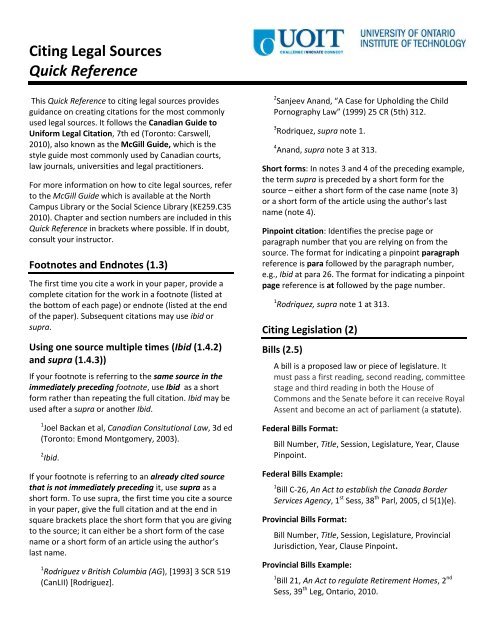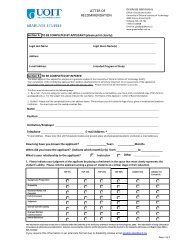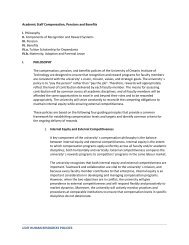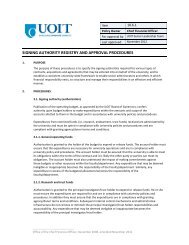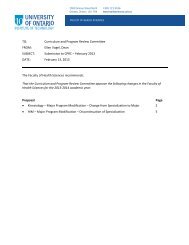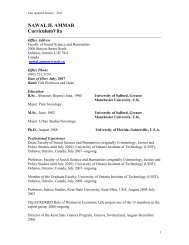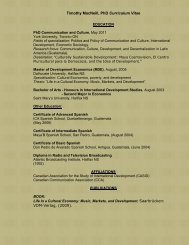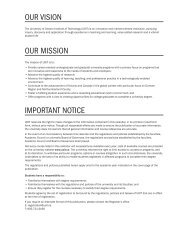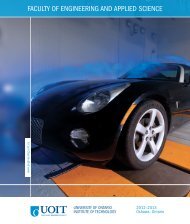Citing Legal Sources Quick Reference
Citing Legal Sources Quick Reference
Citing Legal Sources Quick Reference
Create successful ePaper yourself
Turn your PDF publications into a flip-book with our unique Google optimized e-Paper software.
<strong>Citing</strong> <strong>Legal</strong> <strong>Sources</strong><strong>Quick</strong> <strong>Reference</strong>This <strong>Quick</strong> <strong>Reference</strong> to citing legal sources providesguidance on creating citations for the most commonlyused legal sources. It follows the Canadian Guide toUniform <strong>Legal</strong> Citation, 7th ed (Toronto: Carswell,2010), also known as the McGill Guide, which is thestyle guide most commonly used by Canadian courts,law journals, universities and legal practitioners.For more information on how to cite legal sources, referto the McGill Guide which is available at the NorthCampus Library or the Social Science Library (KE259.C352010). Chapter and section numbers are included in this<strong>Quick</strong> <strong>Reference</strong> in brackets where possible. If in doubt,consult your instructor.Footnotes and Endnotes (1.3)The first time you cite a work in your paper, provide acomplete citation for the work in a footnote (listed atthe bottom of each page) or endnote (listed at the endof the paper). Subsequent citations may use ibid orsupra.Using one source multiple times (Ibid (1.4.2)and supra (1.4.3))If your footnote is referring to the same source in theimmediately preceding footnote, use Ibid as a shortform rather than repeating the full citation. Ibid may beused after a supra or another Ibid.1 Joel Backan et al, Canadian Consitutional Law, 3d ed(Toronto: Emond Montgomery, 2003).2 Ibid.If your footnote is referring to an already cited sourcethat is not immediately preceding it, use supra as ashort form. To use supra, the first time you cite a sourcein your paper, give the full citation and at the end insquare brackets place the short form that you are givingto the source; it can either be a short form of the casename or a short form of an article using the author’slast name.1 Rodriguez v British Columbia (AG), [1993] 3 SCR 519(CanLII) [Rodriguez].2 Sanjeev Anand, “A Case for Upholding the ChildPornography Law” (1999) 25 CR (5th) 312.3 Rodriquez, supra note 1.4 Anand, supra note 3 at 313.Short forms: In notes 3 and 4 of the preceding example,the term supra is preceded by a short form for thesource – either a short form of the case name (note 3)or a short form of the article using the author’s lastname (note 4).Pinpoint citation: Identifies the precise page orparagraph number that you are relying on from thesource. The format for indicating a pinpoint paragraphreference is para followed by the paragraph number,e.g., Ibid at para 26. The format for indicating a pinpointpage reference is at followed by the page number.1 Rodriquez, supra note 1 at 313.<strong>Citing</strong> Legislation (2)Bills (2.5)A bill is a proposed law or piece of legislature. Itmust pass a first reading, second reading, committeestage and third reading in both the House ofCommons and the Senate before it can receive RoyalAssent and become an act of parliament (a statute).Federal Bills Format:Bill Number, Title, Session, Legislature, Year, ClausePinpoint.Federal Bills Example:1 Bill C-26, An Act to establish the Canada BorderServices Agency, 1 st Sess, 38 th Parl, 2005, cl 5(1)(e).Provincial Bills Format:Bill Number, Title, Session, Legislature, ProvincialJurisdiction, Year, Clause Pinpoint.Provincial Bills Example:1 Bill 21, An Act to regulate Retirement Homes, 2 ndSess, 39 th Leg, Ontario, 2010.
<strong>Citing</strong> Books (6.2)Format:Author (as name appears on front page), Title (Placeof publication: Publisher, Year).Book with a single author:1 H Patrick Glenn, <strong>Legal</strong> Traditions of the World(Oxford: Oxford University Press, 2000).Book with three authors: authors areseparated by a comma and the “&” symbol:1 Kathleen Stewart, Drew Dowling & Laurie Priske,How to Survive the First Semester (Oshawa:Thomson, 2004) at 135.Book with more than three authors includeonly the first author’s name and “et al”:1 Joel Backan et al, Canadian Constitutional Law, 3ded (Toronto: Emond Montgomery, 2003) at 125.Article in an edited collection:Format:Author of article (as name appears on front page),“Title of Article” in Editor (as name appears on titlepage), ed(s), Title of Book (Place of publication:Publisher, Year).Example:1 Gabriel J Chin, “Race, the War on Drugs andCollateral Consequences of Criminal Conviction” inChristopher Mele & Teresa A Miller, eds, CivilPenalties, Social Consequences (New York:Routledge, 2005) 43 at 45.<strong>Citing</strong> Newspapers (6.16)Format:Author, “Title of Article”, Newspaper (Date) Page(Electronic Service / Source if Applicable).<strong>Citing</strong> Government Documents (4)Government documents include a variety of diversesources and can be applied to documents directlypublished by a parliamentary body. See chapter 4 in theMcGill Guide for more detailed instructions andexamples.Parliamentary Papers (4.1)Debates Format:Jurisdiction, Legislature, Title, Legislative Session,Volume or Number (date) Pinpoint (speaker).Debates Example:1 Ontario, Legislative Assembly, Official Report ofDebates (Hansard), 37th Parl, 2nd Sess, No 53 (18October 2001) at 2819 (Julia Munro).Non-parliamentary Papers (4.2)General Format:Jurisdiction, Issuing Body, Title, Volume (publicationinformation) Pinpoint (Additional information).General Example:1 Alberta, Office of the Child and Youth Advocate,2009-2010 Annual Report, (Edmonton: Child andYouth Advocate, 2011) at 44.Reports Published Separately (4.1.7)Jurisdiction only needs to be listed if it is a province.Format:Jurisdiction, Legislature, Issuing body, Title (date)Pinpoint (Chair if applicable).Example:1 House of Commons, Standing Committee onAgriculture and Agri-Food, The future role of thegovernment in agriculture (June 2002) at 10 (Chair:Charles Hubbard).Example:1 Bill Curry, “PM, premiers work out deal onaboriginal health care”, The Globe and Mail (26November 2005) A4 (CPI.Q).http://www.uoit.ca/library September 2011 Page 3
International Materials (5)There is no general form when citing internationalmaterials. For resources not described in thissection, consult section 5 of the McGill Guide formore information.Treaties and Other International Agreements(5.1.1)Include the complete title of the treaty.If names of signatories/parties are in the title,shorten them to reflect common usage but do notabbreviate (United States not United States ofAmerica and not US).If names of signatories/parties are not in the title,include the shortened names after the title, betweencommas.Format:Title, Parties (if applicable), Date of signature, Treatyseries reference, Other source (Other information(optional)).Example:1 Treaty Relating to Boundary Waters and QuestionsArising with Canada, United States and UnitedKingdom, 11 January 1909, 36 US Stat 2448, UKTS1910 No 23.Charter of the United Nations Documents(5.1.2.1)The Charter of the United Nations does not require afull citation. Cite the charter as:1 Charter of the United Nations, 26 June 1945, Can TS1945 No 7.<strong>Citing</strong> Online Materials (6.21)For materials found online, provide a full citation for thetype of source (e.g. government document) and theninsert “online: name of website ” as in the PrivacyCommissioner example below.1 Office of the Privacy Commissioner of Canada,Protecting Your Privacy on the Internet: Canada’sNew Privacy Laws (Fact Sheet) (Ottawa: Office of thePrivacy Commissioner of Canada, 2004), online:Privacy Commissionerhttp://www.privcom.gc.ca/fsfi/02_05_d_13_e.asp.Bibliographies (1.1)A bibliography is a list of all the sources you have citedwithin the body of your paper, listed in alphabeticalorder. In most cases, you will be expected to include abibliography at the end of your paper in addition toyour footnotes or endnotes.Your bibliography should be divided into 3 mainsections: jurisprudence, legislation, and secondarysources. If a source does not fit into a defined section, aresidual section entitled ‘other materials’ can be used.Consult with your professor if you have any furtherquestions.Need More Help?Contact the Library:Web site: http://www.uoit.ca/library/index.phpNorth Campus Library: 905.721.8668 ext. 2390Social Science Library: 905.721.8668 ext. 5644International Court of Justice (5.2.2)Rules or Acts Format:Title, [volume number], name of publication, firstpage or document number.Example:1 Travel and Subsistence Regulations of theInternational Court of Justice, [1947] ICJ Acts & Doc94.http://www.uoit.ca/library September 2011 Page 4


